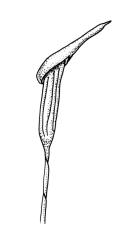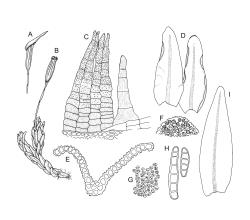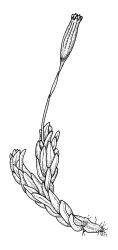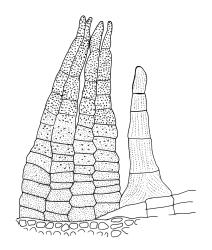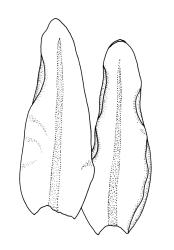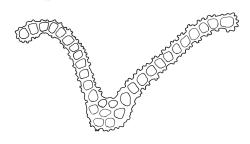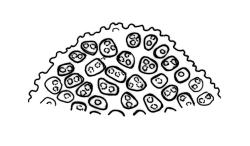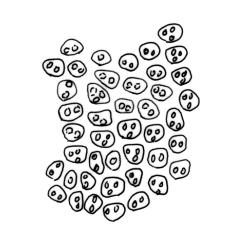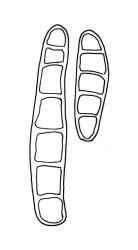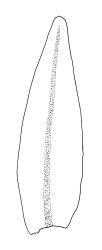- ≡ Zygodon obtusifolius Hook., Musci Exot. 2, 159 (1819)
- ≡ Bryomaltaea obtusifolia (Hook.) Goffinet in Goffinet & Vitt, Bryol. Twenty-first Cent., 151 (1998)
- = Zygodon neglectus Müll.Hal., Hedwigia 37: 133 (1898)
The following species description is modified from Lewinsky (1990).
Plants small, mostly less than 5 mm, occasionally to 10 mm, densely tufted, dark to light olive-green or brown-green above and brown to black below, dull. Stems much branched, curved when dry, in cross-section with small incrassate cortical cells and lacking a central strand; rhizoids present and often dense on lower stems, much branched, pale brown, finely papillose. Leaves appressed and erect when dry, spreading when moist, ligulate or ovate-oblong, obtuse or rounded, entire (but crenulate from projecting papillae), not decurrent, moderately keeled (and the costae obscured in adaxial surface view), mostly 0.6–1.0 × 0.2–0.3 mm; margins recurved to revolute below; upper laminal cells ± isodiametric, subquadrate, oval, or irregular, not arranged in rows, unistratose, moderately bulging, with several (to c. 4) strongly projecting papillae on both surfaces, mostly 9–12 μm in greater diam.; basal cells similar in shape or somewhat more oblate, less papillose; alar cells not differentiated. Costa stout and scarcely tapered, ending several cells below the leaf apex, olive-green or yellow-green, c. 45–60 μm wide in lower leaf, obscured in adaxial surface view by laminal cells, the cells on the abaxial surface subquadrate or short-oblong, not differing from the adjacent laminal cells. Gemmae axillary, clavate, green, with (3–)4–6 transverse septa and 75–120 μm long. Laminal and costal KOH colour reaction mostly positive red (occasionally KOH negative).
Autoicous. Perichaetia terminal, usually overtopped by 1 or more innovations, with leaves larger than adjacent vegetative leaves but otherwise not differentiated. Perigonia terminal on short branches arising immediately below the perichaetia or terminal on normal branches, c. 0.3–0.4 mm long, orange-brown; perigonial bracts broadly ovate, enclosing filiform paraphyses and fewer than 10 antheridia. Setae 2–4 mm, sinistrorse, smooth, dark red; capsules exserted, narrowly obovoid-cylindric, becoming more cylindric with age, deeply 8-furrowed throughout when dry, dark red at maturity, 1.0–1.5 mm; exothecial cells irregular in outline, in distinct thick-walled and thin-walled bands; stomata restricted to neck, superficial; annulus not seen; operculum obliquely rostrate from a conic base. Peristome double; sometimes with a fragmentary preperistome; exostome of 8 pairs of teeth, pale, strongly reflexed when dry, transversely striate below and longitudinally striate above (apparently on both surfaces), c. 180 × 90 μm; endostome with 8 (sometimes 16 fide Lewinsky) lanceolate, pale, and papillose-striate segments arising from a very short and striate membrane; the segments c. ⅔ the height of the exostome. Calyptra cucullate, often weakly papillose near the apex by protruding cell ends. Spores globose, finely papillose, (10–)12–15 µm.
Lewinsky 1990, figs 35–54 (as Zygodon obtusifolius); Vitt 1994, fig. 449 (as Z. obtusifolius); Calabrese 2006, figs. 1e, 2c, 6–7 (as Z. obtusifolius).
NI: N Auckland (Mangamuka Gorge, Waiwera, Papakauri, Leigh, Waipoua Forest, Waitakere Ranges) including offshore islands (LB, GB, Waiheke I.), S Auckland (Puaiti Bush, Pukeatua, Pukerimu Bush near Taupō), Wellington (Silverstream); SI: Nelson (Wangapeka River), Marlborough (Kenepuru), Westland (near Kūmara); Ch.
Recorded from a small number of other localities by Lewinsky (1990) but only records from Waikōpiro, Wairoa, and Dannevirke (all in Hawke’s Bay L.D.) extend the range significantly (mostly eastward) on the North I. Lewinsky’s citation of a Gillespies Beach (Westland L.D.) collection by J. Child represents the most southerly N.Z. record and is significant given the paucity of South I. records; it has not been seen.
Anomalous. Reported from Tasmania, Mexico, Central and South America, Africa, and Asia by Lewinsky (1990).
Usually on bark, but the host species are poorly documented. Lewinsky (1990) recorded it from Beilschmiedia, Weinmannia, and Dacrydium. The one Chatham I. collection is from the trunk of Olearia telmatica. Also on exposed roots, rotten logs, and rarely on rock. A collection from Great Barrier I. is recorded from "old fungal growth on a dead kāmahi" (Weinmannia). It is usually found in fairly exposed positions at low elevations. Zygodon gracillimus and Haplohymenium pseudotriste are sometimes associates. On the North I. from near sea level (Waiwera) to at least 760 m (Pukerimu Bush near Taupō); few elevational data are available from the South I.
Most, but not all, specimens of L. obtusifolia exhibit a marked positive red reaction in a 10% KOH solution, visible in the laminal cell walls, costa, and the stem cortex.
No N.Z. species of Zygodon has such rounded vegetative leaves. In the absence of calyptra, L. obtusifolia might be mistaken for a small species of Orthotrichum but the very small (mostly 0.6–1.0 × 0.2–0.3 mm) leaves should preclude confusion, as should the distinctive gemmae and the usual KOH positive red colour reaction. New Zealand species of Orthotrichum with rounded leaf apices (e.g., O. assimile) either have immersed stomata or occur primarily on rock, or both.



